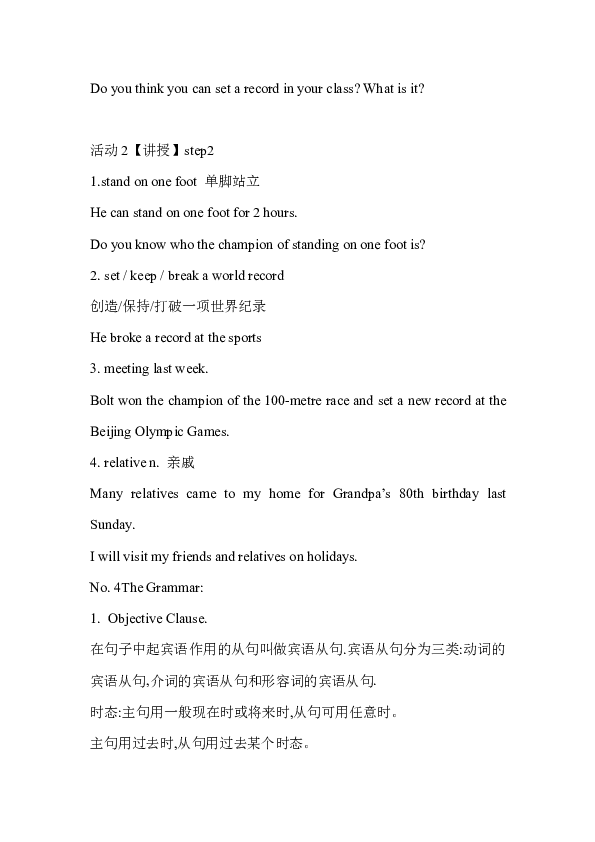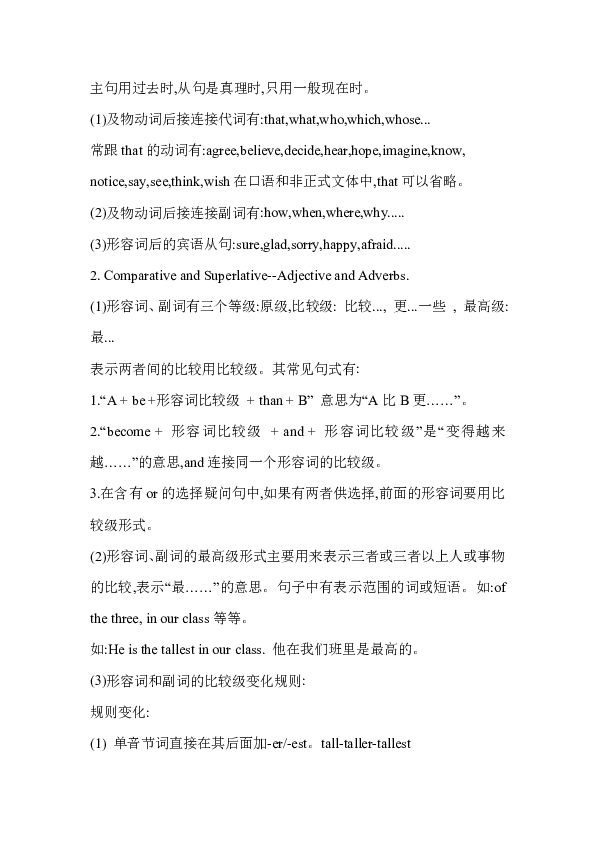Lesson 31 Don’t fall, Danny 教案
文档属性
| 名称 | Lesson 31 Don’t fall, Danny 教案 |

|
|
| 格式 | zip | ||
| 文件大小 | 118.6KB | ||
| 资源类型 | 教案 | ||
| 版本资源 | 冀教版 | ||
| 科目 | 英语 | ||
| 更新时间 | 2017-03-23 08:58:45 | ||
图片预览



文档简介
Lesson
31
Don’t
fall,
Danny
教案
1教学目标
1.
New
words
and
phrases:
champion,
relative,
stand
on
one
foot,
set
a
new
world
record,
break
a
record.
2.
Understand
the
meaning
of
text.
3.
How
to
talk
about
the
Olympics
and
Records.
2学情分析
The
students
are
clever,
they
are
outgoing
and
brave,
but
they
are
lazy.in
this
lesson,
they
are
very
happy.
3重点难点
How
to
talk
about
the
Olympics
and
Records.
The
Grammar:
Objective
Clause,
Comparative
and
Superlative—Adjective
and
Adverbs.
4教学过程
活动1【导入】step1
Homework
check.
Come
to
“Think
About
It!”
What
world
records
do
you
know
of
Do
you
think
you
can
set
a
record
in
your
class
What
is
it
活动2【讲授】step2
1.stand
on
one
foot
单脚站立
He
can
stand
on
one
foot
for
2
hours.
Do
you
know
who
the
champion
of
standing
on
one
foot
is
2.
set
/
keep
/
break
a
world
record
创造/保持/打破一项世界纪录
He
broke
a
record
at
the
sports
3.
meeting
last
week.
Bolt
won
the
champion
of
the
100-metre
race
and
set
a
new
record
at
the
Beijing
Olympic
Games.
4.
relative
n.
亲戚
Many
relatives
came
to
my
home
for
Grandpa’s
80th
birthday
last
Sunday.
I
will
visit
my
friends
and
relatives
on
holidays.
No.
4The
Grammar:
Objective
Clause.
在句子中起宾语作用的从句叫做宾语从句.宾语从句分为三类:动词的宾语从句,介词的宾语从句和形容词的宾语从句.
时态:主句用一般现在时或将来时,从句可用任意时。
主句用过去时,从句用过去某个时态。
主句用过去时,从句是真理时,只用一般现在时。
(1)及物动词后接连接代词有:that,what,who,which,whose...
常跟that的动词有:agree,believe,decide,hear,hope,imagine,know,
notice,say,see,think,wish在口语和非正式文体中,that可以省略。
(2)及物动词后接连接副词有:how,when,where,why.....
(3)形容词后的宾语从句:sure,glad,sorry,happy,afraid.....
2.
Comparative
and
Superlative--Adjective
and
Adverbs.
(1)形容词、副词有三个等级:原级,比较级:
比较...,
更...一些
,
最高级:
最...
表示两者间的比较用比较级。其常见句式有:
1.“A
+
be
+形容词比较级
+
than
+
B”
意思为“A比B更……”。
2.“become
+
形容词比较级
+
and
+
形容词比较级”是“变得越来越……”的意思,and连接同一个形容词的比较级。
3.在含有or的选择疑问句中,如果有两者供选择,前面的形容词要用比较级形式。
(2)形容词、副词的最高级形式主要用来表示三者或三者以上人或事物的比较,表示“最……”的意思。句子中有表示范围的词或短语。如:of
the
three,
in
our
class等等。
如:He
is
the
tallest
in
our
class.
他在我们班里是最高的。
(3)形容词和副词的比较级变化规则:
规则变化:
(1)
单音节词直接在其后面加-er/-est。tall-taller-tallest
hard-harder-hardest
(2)
以字母e结尾的单音节词在其后面直接加-r/-st。例如:brave-braver-bravest。
(3)
以一个辅音字母结尾闭音节单音节词,双写这个辅音字母再加-er/-est。
例如:big-bigger-biggest;
hot-hotter-hottest。
(4)
以辅音字母+y结尾的双音节词,先把y改为i,再加-er/-est。
例如:happy-happier-happiest。
(5)
其他双音节词和多音节的词,在前面加more和most。例如:
interesting-more
interesting-most
interesting;
carefully-more
carefully-most
carefully
不规则变化:
good/well-better-best
bad/ill-worse-worst
many/much-more-most
little-less-least
far-farther-farthest
badly-worse-worst
No.
5
Finish
“Let’s
Do
It!”
活动3【活动】step3
Read
the
lesson
and
answer
the
questions:
1
How
does
Danny
feel
while
standing
on
one
foot
2
How
long
does
Danny
stand
on
one
foot
Why
does
Danny
give
up
At
last,
the
teacher
explain
the
text
in
Chinese,
make
sure
the
Ss
can
understand
the
meaning
of
text.
活动4【练习】step4
Make
the
Ss
listen
the
text,
then
let
them
read
follow
the
tape.
Sum
up
the
text
what
we
learned,
the
new
words,
phrases,
and
sentences.
Sum
up
the
grammar.
活动5【作业】step5
Finish
the
activity
book
and
the
practice.
Copy
the
new
words
and
phrases
twice.
31
Don’t
fall,
Danny
教案
1教学目标
1.
New
words
and
phrases:
champion,
relative,
stand
on
one
foot,
set
a
new
world
record,
break
a
record.
2.
Understand
the
meaning
of
text.
3.
How
to
talk
about
the
Olympics
and
Records.
2学情分析
The
students
are
clever,
they
are
outgoing
and
brave,
but
they
are
lazy.in
this
lesson,
they
are
very
happy.
3重点难点
How
to
talk
about
the
Olympics
and
Records.
The
Grammar:
Objective
Clause,
Comparative
and
Superlative—Adjective
and
Adverbs.
4教学过程
活动1【导入】step1
Homework
check.
Come
to
“Think
About
It!”
What
world
records
do
you
know
of
Do
you
think
you
can
set
a
record
in
your
class
What
is
it
活动2【讲授】step2
1.stand
on
one
foot
单脚站立
He
can
stand
on
one
foot
for
2
hours.
Do
you
know
who
the
champion
of
standing
on
one
foot
is
2.
set
/
keep
/
break
a
world
record
创造/保持/打破一项世界纪录
He
broke
a
record
at
the
sports
3.
meeting
last
week.
Bolt
won
the
champion
of
the
100-metre
race
and
set
a
new
record
at
the
Beijing
Olympic
Games.
4.
relative
n.
亲戚
Many
relatives
came
to
my
home
for
Grandpa’s
80th
birthday
last
Sunday.
I
will
visit
my
friends
and
relatives
on
holidays.
No.
4The
Grammar:
Objective
Clause.
在句子中起宾语作用的从句叫做宾语从句.宾语从句分为三类:动词的宾语从句,介词的宾语从句和形容词的宾语从句.
时态:主句用一般现在时或将来时,从句可用任意时。
主句用过去时,从句用过去某个时态。
主句用过去时,从句是真理时,只用一般现在时。
(1)及物动词后接连接代词有:that,what,who,which,whose...
常跟that的动词有:agree,believe,decide,hear,hope,imagine,know,
notice,say,see,think,wish在口语和非正式文体中,that可以省略。
(2)及物动词后接连接副词有:how,when,where,why.....
(3)形容词后的宾语从句:sure,glad,sorry,happy,afraid.....
2.
Comparative
and
Superlative--Adjective
and
Adverbs.
(1)形容词、副词有三个等级:原级,比较级:
比较...,
更...一些
,
最高级:
最...
表示两者间的比较用比较级。其常见句式有:
1.“A
+
be
+形容词比较级
+
than
+
B”
意思为“A比B更……”。
2.“become
+
形容词比较级
+
and
+
形容词比较级”是“变得越来越……”的意思,and连接同一个形容词的比较级。
3.在含有or的选择疑问句中,如果有两者供选择,前面的形容词要用比较级形式。
(2)形容词、副词的最高级形式主要用来表示三者或三者以上人或事物的比较,表示“最……”的意思。句子中有表示范围的词或短语。如:of
the
three,
in
our
class等等。
如:He
is
the
tallest
in
our
class.
他在我们班里是最高的。
(3)形容词和副词的比较级变化规则:
规则变化:
(1)
单音节词直接在其后面加-er/-est。tall-taller-tallest
hard-harder-hardest
(2)
以字母e结尾的单音节词在其后面直接加-r/-st。例如:brave-braver-bravest。
(3)
以一个辅音字母结尾闭音节单音节词,双写这个辅音字母再加-er/-est。
例如:big-bigger-biggest;
hot-hotter-hottest。
(4)
以辅音字母+y结尾的双音节词,先把y改为i,再加-er/-est。
例如:happy-happier-happiest。
(5)
其他双音节词和多音节的词,在前面加more和most。例如:
interesting-more
interesting-most
interesting;
carefully-more
carefully-most
carefully
不规则变化:
good/well-better-best
bad/ill-worse-worst
many/much-more-most
little-less-least
far-farther-farthest
badly-worse-worst
No.
5
Finish
“Let’s
Do
It!”
活动3【活动】step3
Read
the
lesson
and
answer
the
questions:
1
How
does
Danny
feel
while
standing
on
one
foot
2
How
long
does
Danny
stand
on
one
foot
Why
does
Danny
give
up
At
last,
the
teacher
explain
the
text
in
Chinese,
make
sure
the
Ss
can
understand
the
meaning
of
text.
活动4【练习】step4
Make
the
Ss
listen
the
text,
then
let
them
read
follow
the
tape.
Sum
up
the
text
what
we
learned,
the
new
words,
phrases,
and
sentences.
Sum
up
the
grammar.
活动5【作业】step5
Finish
the
activity
book
and
the
practice.
Copy
the
new
words
and
phrases
twice.
同课章节目录
- Unit 1 Spring Is Coming
- Lesson 1 How's the weather?
- Lesson 2 It's Getting Warmer!
- Lesson 3 Sun Is Rising
- Lesson 4 The Spring City
- Lesson 5 Babysitting on a Spring Day
- Lesson 6 Stories about Spring
- Unit 2 Plant a Plant
- Lesson 7 Planting Trees
- Lesson 8 Why Are Plants Important?
- Lesson 9 Gardening with Mary
- Lesson 10 Make Your Garden Grow!
- Lesson 11 Amazing Plants
- Lesson 12 Danny's Plant
- Unit 3 Animals Are Our Friends
- Lesson 13 Danny's Big Scare
- Lesson 14 Amazing Animals
- Lesson 15 The Zoo Is Open
- Lesson 16 The Pear Escaped
- Lesson 17 Save the Tigers
- Lesson 18 Friendship Between Animals
- Unit 4 The Internet Connects Us
- Lesson 19 How Do You Use the Internet?
- Lesson 20 A Computer Helps!
- Lesson 21 Books or Computers?
- Lesson 22 Travel on the Internet
- Lesson 23 The Internet--Good or Bad?
- Lesson 24 An E-mail to Grandpa
- Unit 5 Buying and Selling
- Lesson 25 Raising Money
- Lesson 26 Cookies, Please!
- Lesson 27 Business English
- Lesson 28 Ms. Liu's Great Idea
- Lesson 29 How to Push a Product
- Lesson 30 A Cookie Sale
- Unit 6 Be a Champion!
- Lesson 31 Don't Fall, Danny
- Lesson 32 My Favourite Record
- Lesson 33 2800 Years of Sports
- Lesson 34 Modern Olympics
- Lesson 35 The Dream Team
- Lesson 36 Classroom Olympics
- Unit 7 Know Our World
- Lesson 37 Let's Learn Geography!
- Lesson 38 The World Is a Big Place
- Lesson 39 Ring Up or Call?
- Lesson 40 Body Language
- Lesson 41 A Class of the World
- Lesson 42 North America
- Unit 8 Save Our World
- Lesson 43 Let's Clean Up!
- Lesson 44 Environment Clubs
- Lesson 45 Let's Sort Garbage!
- Lesson 46 Protect Our Environment
- Lesson 47 Connected to Nature
- Lesson 48 Garbage Is Interesting!
